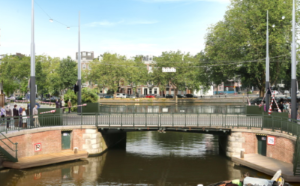Get in touch with us
Open application



In Marnixstraat, in the heart of Amsterdam, lies the Bullebak bridge: a historic bridge on an important route for cyclists and public transport. Due to the substantial increase in traffic, the bridge no longer meets today's requirements. To ensure it will last another 100 years, the Bullebak bridge will be completely renewed.
‘There had been problems concerning its opening and closing for a while. In the summer of 2018, the bridge even spontaneously opened due to thermal expansion,’ says Richard Kruseman. He is seconded to the Groningen Machine Factory Rusthoven, as Mechanical Engineer of VIRO. ‘BAM was awarded the contract to replace the bridge. They outsource the part of the contract concerning steel to Rusthoven. This concerns the motor and the two roadways of the bridge.’
Heritage under a heavy burden
The Bullebak is a double bascule bridge; a two-part bridge of which both halves are lifted. The counterweights of the bridge are located under the road surface: ‘The weight ensures that the motor does not have to work as hard to raise the bridge as it otherwise would.’ It is up to Richard and his fellow Rusthoven engineer Wiebe Klijnsma to work out the design of the bridge within the set framework and make it producible. In doing so, they take into account the wishes of the architect and the urban load: ‘The bridge also features tram tracks. Among other things, this requires a critical approach to size tolerances. Naturally, you don’t want a bulge in the rails at the bridge crossing.’ The historical value of the Bullebak makes the project even more challenging: ‘The bridge is on the heritage list and is protected as a monument. The classic image of Amsterdam's canals must not be damaged. We have to work within those frameworks.’
Prefabricated transport and installation
The replacement is a complicated job, as the bridge is both wedged between vulnerable quay walls and surrounded by cables and pipes. How do they handle this? ‘The movable part of the bridge deck is called a roadway. There are two of them, one on each side. We place the roadways as completely assembled parts on a ship that transports them from Groningen to Amsterdam. One such roadway weighs as much as 60 tonnes. It is quite a challenge to keep both roadways with counterweights in balance on the ship. At the Bullebak location, a floating crane moves the roadways directly from the ship onto the foundation plate. It is a critical operation, because everything must then fit exactly.’
Bridging 100 years
The bridge has a total length of 30 metres; the span over the canal is 10 metres. The road surface is 12 metres wide: ‘This approach means that the bridge deck is put in place in two stages. At that time, the new motor will have been installed in the “basement” of the bridge. It is then just a matter of fine-tuning things; the new Bullebak will essentially be done in one go.’ The engineer from VIRO and his colleague from Rusthoven worked on the project for four-and-a-half months. From commissioning to final design: ‘At the end of 2021, the bridge will be installed and it will be good for at least another 100 years.’